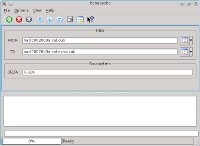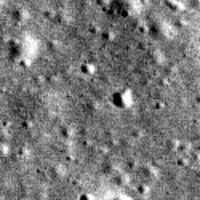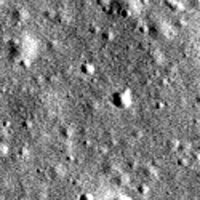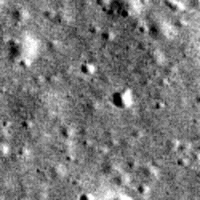lronacecho
Removes echo effects from a LRO NAC image
lronacecho implements a correction designed to remove an echo effect from LROC NAC images. In the summer of 2011, an echo effect was discovered in the NAC detectors. The signal in each pixel is replicated to a smaller extent in the pixel on the same line 2 columns over, 1 collumn in summed NACs. MSSS was consulted and it was confirmed this is a detector effect related to the high speed (>3000 lines/second) of the NAC detectors. The even and odd columns of the detector have separate signal processing chains, so when one pixel is read out, the next pixel with the same signal processing chain is two columns over. There is no measurable effect 4 columns over; the echo has no echo.
The size of the echo effect was determined by analyzing the signal at the edge the detector mask on each side of many NAC images, and by analyzing images with stars that had well-defined ghosts offset by two pixels. The effect is large enough that an inverse technique is needed to correct it with sufficient accuracy. The analysis determined that the echo is a larger percent of the signal for signals less than 100 DN. However, the correction uses a fixed fraction equal to
A brute force inverse technique derived from simple substitution was used early in the development of the echo correction. Let
So, we have the line of the actual image
Note, however, that this equivalent to:
So we can calculate the new correction factors from the previously corrected pixels (the
In practice it has proven most successful to apply the echo correction after the flat field correction.
The effect of the echo correction on the flat field is not significant.
Categories
Related Objects and Documents
Applications
History
| Jacob Danton | 2011-11-17 | Original version |
| Adam Licht | 2013-01-15 | Updated default Delta parameter per D. Humm. Added Documentation. |
| Adam Licht | 2013-01-25 | Updated algorithm to normalize the output cub after preforming the correction, to preserve radiometric calibration. |
| Adam Licht | 2013-04-05 | Added a new parameter "SMOOTHINGROWS". This specifies the number of samples to slowly ramp up the constant in. Fixed how special pixels were handeled in the normalization step. |
Parameters
Files
| Type | cube |
|---|---|
| File Mode | input |
| Filter | *.cub |
| Type | cube |
|---|---|
| File Mode | output |
| Pixel Type | real |
Parameters
| Type | double |
|---|---|
| Default | 0.326 |
| Type | integer |
|---|---|
| Default | 20 |
Example 1
Removing echo from NACL (no summing) image
Command Line
lronacecho lronacecho from=nacl00020d3a.cal.cub to=nacl00020d3a.cal.echo.cub
GUI Screenshot
Removing echo from nacl00020d3a.cal.cub
Removing echo from nacl00020d3a.cal.cubThis is what the graphical interface should look like in a typical run. The input to lronacecho in this example is nacl00020d3a.cal.cub, a calibrated LRO NACL image with no summing. The resulting image, nacl00020d3a.cal.echo.cub, will have echo effect removed.
Input Image
Input image nacl00020d3a.cal.cub
Input image nacl00020d3a.cal.cubThis is a small area of the input to lronacecho, a calibrated LRO NACL image. The features are slightly blurred due to an echo effect.
Output Images
Output image nacl00020d3a.cal.echo.cub
Output image nacl00020d3a.cal.echo.cubThis is a small area of the output to lronacecho, a calibrated LRO NACL image with echo effects removed. The blurring from the echo effect has been removed.

